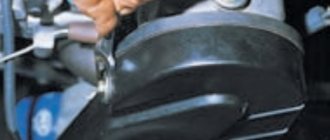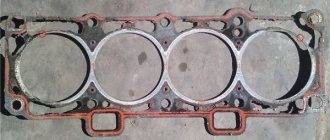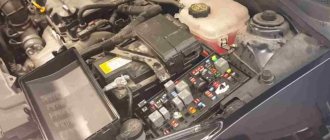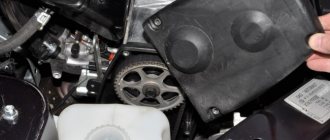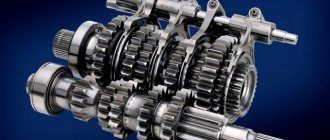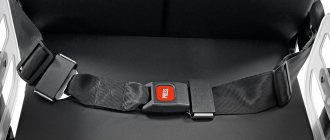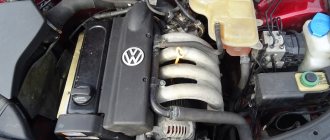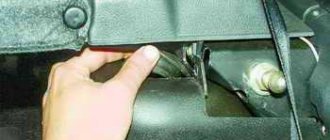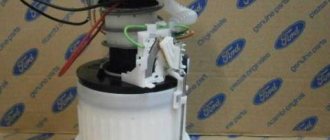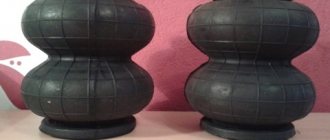How to find an antifreeze leak
Since coolant can leak from different places in the system, you need to know where and how to look for the problem area.
By visual inspection, you can identify areas of coolant leaks. The more it leaks, the easier it is to find the leak. The procedure should begin with the pipes, since on many cars they have free access. During the inspection, you need to carefully check each hose of the cooling system, especially if the elements have been changed a long time ago.
The pipes are checked by visual inspection
In hard-to-reach places, you can use a mirror to check. Damaged hoses must be replaced. If no leaks are found on them, they are still worth inspecting for preventive purposes. Additionally, the clamps are subjected to visual inspection. Sometimes it happens that a coolant leak is caused by a loose fastener. In this case, tightening the clamps more tightly allows you to get rid of the problem in question.
Replacement timing and choice of coolant
During production, liquids of standard G12 must be filled into the radiator device of the cooling system. The service life of such refrigerants is about 250 thousand kilometers or five years, whichever comes first. This applies to the initial replacement of consumables. If you use a different class of antifreeze, which is highly not recommended for the cooling systems of Volkswagen Passat cars, then the timing of replacing the fluid will be different. On average, G11 antifreezes retain their properties for three years or 100-150 thousand km.
The following symptoms may indicate that you need to replace and add new refrigerant:
- Poor stove operation. If you feel that the stove has begun to function less efficiently, you need to check the condition of the working substance.
- A foam emulsion has appeared in the antifreeze container located in the engine compartment. When a liquid loses its properties, it will not be able to perform its functions. As a result of chemical reactions, foam will begin to appear in the system.
- The car engine periodically overheats. If the coolant cannot cool the power unit, it will cause it to overheat. The fluid needs to be changed.
- Formation of sediment in a container in the engine compartment. When physical properties are lost, a chemical reaction occurs, as a result of which a precipitate appears in the system. They can clog its highways.
Squeezes antifreeze out of the expansion tank
When operating a car with a cooling system, problems sometimes arise that are of various types. One of these is squeezing out the coolant from the expansion tank. There can be many reasons for this phenomenon. Therefore, it is worth dwelling on each of them separately, considering the signs of manifestation and the consequences of untimely repairs.
The most common problem in which antifreeze is expelled from the expansion tank is the burnout of the gasket between the engine block and the head. The seal can be damaged for various reasons, for example, when the engine overheats. You can determine that a breakdown is caused by a loss of tightness as follows:
- Start the engine and open the reservoir cap.
- If air bubbles come from the main hose when idling, this clearly indicates a problem with the gasket.
If the cylinder head gasket is damaged, antifreeze will leave the system.
Gasket breakdown can be different:
- if the seal is damaged internally, white smoke will be observed from the exhaust pipe;
- if the outer part of the gasket is damaged, the antifreeze will be squeezed out, which cannot be missed by the smudges on the cylinder block.
The second option is a rather rare case. Most often, it is the inner part of the seal that is damaged, and coolant gets inside the cylinder. A gasket failure can lead to serious consequences, namely overheating and engine jamming, as well as water hammer of the cylinder head and the appearance of cracks in the unit housing.
How much antifreeze is in the engine of a Daewoo Nexia
The volume of the cooling system in the eight-valve Nexia N-100 engines is 6.2 liters.
Naturally, when replacing it is rarely possible to drain the antifreeze completely. In any case, about a liter of liquid will remain in the system. Therefore, 5-5.5 liters will be enough for replacement. The total volume of antifreeze in the Nexia N-150 cooling system 16 valves is 6.7 l
. The situation here is similar - when replacing, some of the liquid remains in the system, so when replacing, approximately the same amount of liquid will be required. However, in the future, situations may arise (and they will certainly arise) when it will be necessary to add fluid to the normal level. That's when the rest of the new antifreeze will come in handy.
Sometimes it is more profitable to take a 10-liter canister than to fill it with liter bottles.
Replacement Regulations
The schedule for replacing the fluid depends on its composition, engine operating conditions and the condition of the cooling system.
.
.
This is what very old coolant looks like - it needs urgent replacement.
You need to understand that there are no ideal conditions and the condition of the liquid must be monitored as often as possible. Antifreeze is close to losing its properties when:
- the original color is lost, the liquid becomes brown;
- an oily film is visible on the surface of the liquid in the expansion tank;
- the liquid becomes cloudy, a foreign suspension appears;
- foam is visible in the expansion tank;
- The engine often overheats without significant load.
It is unacceptable to force the engine to run with coolant that is not worn out, so at the first sign of the antifreeze losing its properties, we begin replacing it.
Antifreeze leaves the expansion tank, causes and consequences
Good day to all! Many have probably encountered a situation where antifreeze is thrown out of the expansion tank. At the same time, not everyone knows what this is connected with and for what reasons it occurs.
If the engine cooling system is working correctly and correctly, it's just great. Because under such conditions the internal combustion engine will work for a long time and properly.
The system is sealed, in good working order, cooling liquid moves freely inside it, heat is removed, and operating temperature is maintained.
But when malfunctions occur, this entails engine overheating, serious damage to the internal combustion engine, expensive repair work, and sometimes even a complete replacement of the power plant. And if your car suddenly starts leaking antifreeze or antifreeze, you should quickly begin to find out the reasons and eliminate the provoking factors.
A little about the problem
The expansion tank is an integral component of the internal combustion engine cooling system. The main task of this element is to dampen pressure fluctuations inside pipelines that arise as a result of a decrease or increase in the volume of cooling liquid when it is cooled and heated, respectively.
Such a capacity allows you to reduce mechanical loads on the entire cooling system. Thus, the internal combustion engine is protected from water hammer and air locks.
Essentially, the tank replenishes the liquid deficit in the cooling lines and acts as a receiving tank when excess coolant appears, which occurs when the composition is heated. Structurally, it is a seemingly ordinary sealed plastic tank.
An integral element of the unit is the expansion tank cap, which also serves as a valve. With its help, pressure enters the tank from the outside when there is a deficiency in the system, or excess pressure is released.
When the coolant heats up, the liquid gradually expands, thereby filling the tank space. In parallel with the increase in evaporation from heating, the internal pressure increases.
For various tank designs and specific car engines, along with their cooling system, certain threshold pressure values are provided. When they are reached, a valve begins to operate, which expels excess pressure from the system.
But there are situations when the antifreeze is already boiling, the pressure increases, but it does not release. Instead, it throws out the liquid itself. That is, the valve does not cope with its tasks.
Why this happens and how to deal with it is the key question of this material.
Moreover, emissions can appear after the engine is stopped and during operation of the power plant. Let's understand the reasons.
Main reasons
- There are several main reasons for the release of coolant through the expansion tank.
- They are divided into several groups depending on what exactly the problems are associated with.
- Similar phenomena occur on a variety of vehicles, including:
- VAZ 2114;
- Gazelle;
- KAMAZ;
- DAF;
- Lada Kalina;
- Nissan Almera;
- Mitsubishi Lancer;
- Hyundai Accent;
- Volkswagen Polo;
- Nissan Qashqai;
- Daewoo Lanos;
- Lada Granta;
- Mazda 6;
- Mercedes;
- Audi A5, etc.
The likelihood of encountering a similar problem is higher for cars with a higher mileage. Although we cannot rule out antifreeze emissions from cars that were only recently purchased and put into operation.
Let's look at the possible reasons separately.
Tank malfunctions
At first it may seem that the tank is designed extremely simply, and there simply cannot be any significant problems with it.
But it is because of the tank that the coolant most often begins to eject.
- The seal is broken. Antifreeze has a high fluidity, which is why it can penetrate even through small cracks that are not visually noticeable. Thus, when the pressure increases, the liquid is squeezed out. Check for stains under the car after parking. It is best to completely replace the tank if there is leakage;
- Defective threaded connections. When checking the expansion tank cap, pay attention to the threads of the neck and the valve itself. Cheap and low-quality products often have burrs and chips, which make a tight fit impossible. An increase in pressure provokes coolant leakage through these channels;
- Valve. The valve cover is also a common cause of fluid leaking from the reservoir. Moreover, the problem is quite easy to identify. Everything works fine at idle. But by increasing the speed, under load, the liquid is literally pushed out from under the valve. First try to disassemble and clean the element. If this does not help, the valve needs to be replaced.
But these are not the only possible reasons. Let's move on in search of the truth.
If circulation is disrupted, the fluid overheats greatly, pressure increases and coolant is squeezed out through the valve cover.
There are several reasons here.
- Thermostat is faulty. If it does not work, then the liquid will flow only in a small circle, bypassing the antifreeze cooling radiator. In this situation, the motor will overheat. It is necessary to check and, if necessary, change the unit;
- Air lock or clogged channels. Blockages appear due to scale, mechanical debris, improper mixing of antifreeze, etc. This is where the radiator is cleaned and flushed;
- Water pump failure. I have already talked about the signs and causes of a malfunctioning water pump in a separate article. Just follow the link.
The potential reasons don't end there. There is one more important point that is worth paying attention to.
Leak formation
Most often, motorists are faced with a shortage of coolant in the cooling system. When the volume of antifreeze drops, the temperature rises as the engine cools. Heating leads to active evaporation and an increase in pressure.
If, when the engine cools down, the level remains unchanged in the tank, then you need to look for a problem in the circulation. And when the level drops, then the seal is broken. That means there is a leak somewhere.
There are several main probable causes of leakage:
- The pipes and hoses of the system are worn out and aged. They will need to be replaced, strengthening the new parts with additional clamps to increase the reliability of the connections;
- Cracks in the heater cores and cooling system. If the problem is in the stove, then antifreeze will leak into the cabin. Usually at the front passenger's feet;
- Problems with the pump and thermostat seals. Look for traces of antifreeze near those elements that act as suspects;
- The cylinder head gasket is broken. In this case, the cylinder head gasket will need to be replaced. The danger is that the coolant can penetrate the engine cylinders or lubrication system, mixing with the oil. The consequences can be extremely disastrous for the engine, including jamming of the internal combustion engine.
Now you are clearly convinced that there is nothing good in throwing out antifreeze through the expansion tank. When the first signs appear, be sure to stop the car, start looking for the causes and eliminating them.
If you have any difficulties with diagnostics or repairs, you can always contact a car service center.
I think we can end here. If you have anything to add to the material, want to share your personal experience or give useful advice, write in the comments.
Thanks everyone! Subscribe, invite your friends to join us and expect a lot of new and useful materials!
Antifreeze or antifreeze are special liquids that protect car engines and radiators from overheating in hot periods and hypothermia in cold weather. Due to its unique chemical composition, antifreeze has a high boiling point, ranging from 108˚C to 197˚C.
The positive properties of antifreeze contribute to stable engine operation. When the cooling system is functioning properly, the antifreeze does not boil, as a result of which the motor is able to perform its main functions.
One of the most important advantages of coolants is their safety and the absence of destructive effects on the cooling system.
In cases where antifreeze leaves the expansion tank, overheating of the power unit is observed.
The coolant located in the tank is supplied to the radiator and engine through special pipes. In the process of circulating a liquid for the purpose of cooling, it is heated and steam is formed.
The hole located in the expansion tank cap is designed to allow the generated steam to escape.
Excess pressure in the cooling system resulting from expansion of the antifreeze volume occurs.
If a situation arises when antifreeze is released through the expansion tank, then it is necessary to look for the reasons that caused this defect.
The expansion tank is a plastic container equipped with an antifreeze level sensor and a valve that regulates the coolant pressure inside the tank.
Why is there a situation where antifreeze runs out? If there are cases of antifreeze escaping from the expansion tank, then there is a problem in the cooling system that caused this problem:
- Natural aging and wear of the rubber pipes connecting the engine to the radiator.
- Defects in the thread of the expansion tank cap.
- Pressure valve failure.
- Depressurization of the tank due to failure of the sensor that monitors the coolant level.
- Insufficient thickness, thinning of the walls of the expansion tank.
- Antifreeze boiling.
Rubber tubes located between the engine and radiator serve to circulate coolant. The formation of cracks in the lines leads to a violation of the tightness of the system.
Squeezing out antifreeze and reducing its amount lead to an increase in temperature in the cooling system.
When heated, the liquid increases in volume, which entails an increase in pressure, pushing antifreeze into the expansion tank and out of it.
Threaded connections in the tank and lid often have burrs, irregularities and chips, which prevents the surfaces from fitting tightly when tightened. Antifreeze knocks out of the expansion tank - this means coolant under pressure comes out through the neck of the tank due to poor-quality screwing of the cap.
Under antifreeze pressure, the thinned walls of the tank often cannot withstand the loads, they rupture and intensive ejection of antifreeze occurs.
Replacing coolant in Volkswagen Passat B5
Coolant - what to do with it? And so, according to the official dealer, the coolant is filled for the “entire” service life of the car. Replacing Volkswagen Passat coolant After all, none of us have been frying potatoes in the same oil for 5 years, for example. And we are all not stupid people and we understand that any technological fluid comes to an end and it ceases to perform its functions either completely or partially. Got busy with the issue.
How to drain antifreeze from an engine. On B5 there was a tap on the lower left side near the radiator. On B7 there is just a hose with a clamp. To get to the clamp. You need to remove the left and right intercooler pipes by unscrewing the clamps with a flat screwdriver.
Replacing Coolant Passat B3
If you neglected to replace the coolant, the cooling system will work ineffectively due to poor passage of channels clogged with sediment and rust. Therefore, it is advisable to flush the system before adding new fluid. For rinsing, use either clean or distilled water. The engine and radiator are flushed separately.
How to fill?
Before filling, you should prepare the coolant. Before filling in the coolant, it is necessary to check the integrity of the hose and the tightening of the clamps. If everything is in order, the cooling system is filled with new coolant. Fill slowly to avoid any air bubbles. The liquid should be poured to a level just below the maximum. Expansion tank in the Volkswagen Passat After the replacement is completed, it is necessary to check the tightness of the connection between the thermostat and the cooling pump, the hoses with the radiator and the pump.
Places where antifreeze leaks are possible are identified by the presence of a white coating. The presence of cracks and the elasticity of the sleeves is checked by squeezing and bending them. Then install the power steering pump and drive belt.
Screw on the coolant cap on the expansion tank. After this, you should start the engine and let it run for some time in idle mode at accelerated speed. As soon as the temperature sensor gives a signal to the fan and it turns on, you should turn off the engine and check the coolant level in the tank. Move the heating system temperature regulator to the maximum temperature position.
Loosen the clamp securing the fluid return hose from the heater radiator. Move the hose from the fitting as much as possible so that the fitting does not cover the hole in the hose to remove air. To remove air, unscrew the two plugs that are located on the cooling system pipes next to the expansion tank. Screw in a threaded adapter with a tube with a diameter of 42 mm and a height of mm with the cover.
This is necessary to completely fill the cooling system with liquid and displace air from there. Fill the liquid into the Volkswagen Passat coolant reservoir until the coolant flows out through the screw plugs to remove air.
The plugs must be screwed in with a force of 20 N.
Fill the coolant into the cooling system until it begins to flow out through the hole in the hose.
Push the hose onto the fitting as far as it will go and secure it with clamps. Lower the revs to idle and wait until the car warms up. Turn off the engine. Check the coolant level. If necessary, top up. When the engine is warm, the coolant should be at the MAX level.
When the engine has cooled down between MIN and You can also change the coolant in a garage. To do this, you just need to acquire the necessary tools and have a little experience.
The entire replacement procedure takes no more than hours.
What to do if antifreeze runs out?
If you begin to notice that the antifreeze level is constantly falling, you should check the entire technical condition of the car. Most often, the cause of this phenomenon is a worn cylinder head. If you do not start solving the problem in a timely manner, the temperature of the power unit increases significantly.
- A sharp increase in oil consumption.
- Emission of thick white smoke from the exhaust pipe.
- Change in the consistency of the engine oil, the appearance of bubbles in it.
Antifreeze getting into oil is quite dangerous. Due to the mixing of liquids, the oil begins to lose its physical properties. It becomes thicker and more viscous. Because of this, all internal channels become clogged, which negatively affects the heat exchange of the power unit. This may lead to the following problems in the future:
- Rapid consumption of antifreeze.
- Rapid wear of the main and connecting rod bearings of the crankshaft.
- Excessive piston wear.
- Overheating of the power unit.
Before you begin to combat this phenomenon, you should conduct a complete diagnosis of the vehicle. First of all, you need to determine what caused the breakdown. In the vast majority of cases, a decrease in the volume of antifreeze is associated with a leak from the cylinder block gasket. Replacing it completely solves the problem. You can do this at any service station or even yourself. To do this, you should adhere to the following algorithm:
- Purchase the necessary list of spare parts in advance. This process should be approached as responsibly as possible; it is best to select parts based on the vehicle code.
- Remove the old cylinder block cover. It is usually secured with 8 or 12 bolts. Before you begin, you should disconnect all components and pipes located on top. You will also have to remove filters and wiring.
- Unscrew the cylinder head. Do everything as carefully as possible, because the bolts will not be tightened too much. Because of this, antifreeze gets into the engine. Remove everything carefully so as not to damage anything.
- In some cases, the bolts may be too tight. Then you will have to remove all the heads. Keep in mind that if after removal you do not find any defects, you will no longer be able to install the old parts. Spare parts are disposable.
- Assembling the cylinder head gasket is carried out in the reverse order. It is important to carefully tighten the bolts to avoid stripping them. The head must be attached in a checkerboard pattern; a pressure gauge is also used to control the force.
How often should the coolant be changed?
The cooling system of an 8- or 16-valve Daewoo Nexia must be periodically filled with new refrigerant. Replacement intervals may vary slightly depending on the vehicle modification. You can read more about intervals in the service manual. Typically, the instructions indicate that replacement should be made after a mileage of 45 thousand kilometers or every three years.
Keep in mind that the service life of antifreeze directly depends on its characteristics. And also on the conditions of use, in particular, on the condition of the cooling system and the region in which the car is operated.
Signs of the need for urgent replacement
The following symptoms may indicate the need for an urgent change of antifreeze in the Daewoo Nexia:
- Poor stove operation. This is especially evident at low negative temperatures. If the coolant loses its properties, it will not be able to effectively circulate through the system and take heat from the engine. Accordingly, this heat is transferred to the car interior.
- Regular engine overheating. Antifreeze cannot properly cool the power unit, causing the latter to overheat.
- Formation of foam on the surface of the refrigerant. If you notice that the coolant in the expansion tank has foamed, this indicates a loss of its properties. In the future, this problem will lead to overheating of the power unit.
- There is sediment at the bottom of the expansion tank in the engine compartment. It can usually be seen with the naked eye. The appearance of sediment also indicates a loss of refrigerant properties. In advanced cases, all the liquid in the system may be in the form of a large lump. In practice, this often happens with the onset of cold weather. Sediment can also form in the radiator, as well as in the cooling system lines. But you can only see it directly in the tank. If there are deposits, antifreeze in the Daewoo Nexia must be replaced. You will need to clean the expansion tank, radiator unit and hoses. So that the new liquid does not mix with the sediment.
- Flakes began to appear on the surface of the antifreeze. They usually form in summer at elevated temperatures.
- The refrigerant has turned brown with a hint of rust, and the natural color has disappeared. If a yellow liquid was used, it may turn brown as a result of loss of properties. The loss of natural color indicates that the coolant has reacted with the metal elements of the radiator device. With the constant use of such antifreeze, the radiator components are destroyed. And its failure will lead to overheating of the car engine.
- Another sign is that the temperature at which the coolant freezes has increased. You can check this at home. For diagnosis you will need a medical syringe, a glass and a thermometer. A little refrigerant, about one hundred grams, should be pumped out of the reservoir under the hood and poured into a glass, which should be placed in the freezer along with a thermometer. The essence of the diagnosis is to check the condition of the fluid every 3 minutes. When it starts to become cloudy, you need to check the thermometer readings. This state of the substance indicates the beginning of crystallization, that is, freezing. The recorded temperature should be checked against the nominal value indicated on the label of the antifreeze package. If you don’t have it saved, use the Internet.
Car cooling system
The cooling system plays an important role in engine operation. Daily use of the car and intense loads lead to heating of the engine and the entire engine compartment, especially in the summer. The coolant, passing through the complex components of the power unit, maintains the engine temperature at an acceptable level (80–100 oC), preventing overheating. It is important to remember that the cooling system is completely sealed and the coolant level should not change from the moment it is filled until it is replaced.
There is no air in the system, so it is important to keep all connections tight
During engine operation, the liquid constantly circulates through the system in a circular sequence, passing through the components of the unit. When the engine heats up, the liquid molecules expand and its volume in the system increases. In order to avoid rupture of elements in the cooling system, an expansion tank is provided. All excess liquid when heated is sent to the tank, and when cooled it is returned back to the system.
A constant decrease in fluid in the expansion tank is a serious signal for the driver. A complete check of the entire cooling system and leak detection is the very first stage of diagnosis. It's not so bad if it's just a leak. It is much more serious when the liquid leaves, but there are no drops or smudges anywhere. In this case, serious problems with the engine may occur, the elimination of which will be very expensive for the car owner.
Leak in the system
Antifreeze goes away for various reasons. The first thing to consider is the leak in the system itself. The following may leak:
- engine radiator;
- stove radiator;
- connecting hoses;
- pump and thermostat;
- expansion tank cap or the tank itself.
You can eliminate smudges with your own hands, in a garage. If there is no opportunity to do this or there is not enough experience, then it is better to entrust the work to professionals and take the car to a car service center.
Antifreeze is leaking - it's time to carefully examine the car's cooling system
Leaks and problems
Over time, your car needs to pay close attention to the pipes and hoses. They may begin to dry out and crack. What causes a leak to form, the worst thing is when it happens on the road, where you can’t get to a service center or a spare parts store.
The radiator filler cap is considered a consumable and therefore must be changed periodically. Because due to a soured bypass valve, the pressure in the system may increase, which will lead to a leak in the cooling system at a weak point.
In this short article we will tell you when and how to replace antifreeze on a Hyundai Accent. If you follow the technical regulations, then it is necessary to completely replace the fluid once every 40 thousand kilometers. But keep in mind that this is according to the regulations; in fact, the interval can either decrease or increase. And the most important role in this is played by the quality of antifreeze and the efficiency of the entire system. Let's start with how to understand that it's time to change the fluid in the Hyundai Accent cooling system.
Signs
There is a quick method to determine external leakage without the help of specialists. A faulty expansion tank, radiator hoses - all these parts are easy to find in the event of a breakdown. The hoses are checked by touch, and if the faulty hose is bent, the antifreeze will simply flow out of it like a fountain. After the hoses, their connections are checked, which can lead to a similar result.
Damage to the cooling system tubes will result in fluid leakage. How to check whether the tubes remain intact in the event of a leak? To check whether this is so, you should place a piece of cardboard under the car and check it after some time. If there are stains on it, then the problem is in the tubes and fasteners. In this case, only their repair can help.
Where does antifreeze go if the radiator malfunctions? If the front window of the car fogs up, the carpet under the front seat gets wet, or condensation occurs, then the cause is a faulty radiator. Getting to it from the salon can be difficult, so you can check its functionality in another way.
Why does antifreeze leak if there is an internal leak? Most likely, it enters the engine system and mixes with the fluids present in it, very often oil. If the exhaust gases have a sweetish smell, and the smoke coming out of the pipe is bright white, then you should check the type and level of oil in the car.
Antifreeze in the engine creates deposits on the dipstick. In the same way, spark plugs are checked, which turn white when there is antifreeze in the engine. It is difficult to repair such a breakdown yourself, so it is better to contact a service station.
If the timing belt guard is dirty, there is likely antifreeze residue on it. To diagnose the problem, you need to remove the timing belt cover. When the cover is removed, you can determine the cause visually; the maintenance problem may be in the pump. This part cannot be repaired; most likely, you will have to buy a new pump.
How to change antifreeze with your own hands?
Now let's dwell on the issue of changing antifreeze or antifreeze. You can replace it with the help of specialists, but we will consider an independent process.
Preparation
To complete the task you will need:
- pliers;
- rags;
- a container where you will collect used antifreeze (for example, it could be an old bucket, basin or cut-off bottle).
Stages of work
To replace antifreeze, you need to complete several steps:
- Drain off the used fluid.
- Flush the system.
- Fill with new coolant.
How to drain?
First, drain the coolant from the engine block:
- The vehicle is driven into a garage with a pit or onto an overpass. To drain the refrigerant from the system as much as possible, the car engine should be warmed up. This will allow the thermostat valve to open. To ensure maximum removal of refrigerant from the system, the left side of the vehicle body should be placed on a jack in the area of the front wheel.
- Open the hood and unscrew the expansion tank cap.
- Climb under the bottom of the car and dismantle the crankcase protection by unscrewing the bolts that secure it with wrenches.
- After the engine has cooled a little (but not completely cold), open the heater valve. Some of the antifreeze may come out of it, so place a container under it in advance.
- Unscrew the drain plug; it is located on the radiator. Under the drain hole, which is located at the bottom of the radiator device, on the right side, place a prepared container to collect the waste. It is not located in the most convenient way. When opened, a stream of coolant will spray onto the body beam and flow down to the ground along it. If you replaced the radiator device, then there may not be a tap on it. Then you will have to disconnect the hose from the unit itself and drain the refrigerant from it.
More visual instructions for draining are presented in the video (the material was filmed and made public by user Artem Li).
Flushing
Once you have drained the refrigerant, the system should be flushed. Do-it-yourself washing is done like this:
- You need to tighten the heater tap and the drain hole on the radiator.
- About 6-7 liters of distilled water are poured into the expansion tank until its level reaches the bottom mark on the tank. Please note that only distillate can be used for flushing; the system cannot be flushed with ordinary tap water.
- Tighten the expansion tank cap and start the power unit.
- After starting the internal combustion engine, the volume of the substance in the reservoir usually decreases quickly. This is due to the removal of air from the cooling system by a pump. If the heater valve was open, then air pockets should not form.
- The engine will run for about five minutes, then turn it off.
- Unscrew the drain plug on the radiator and drain the water from the system. If there is sediment in it and the color is brown, then repeat the washing procedure. This is carried out until the drained liquid is clear.
Watch a detailed video about flushing the cooling system (the material was filmed and published by the STO Kovsh channel).
How to add antifreeze:
- Close the stove tap and tighten the drain plug. If you disconnected the hose from the radiator, reconnect it and securely fix it.
- Fill the system with coolant through the expansion tank. Filling is carried out to the middle of the marks between MIN and MAX.
- Tighten the expansion tank cap and start the engine. Wait until the radiator cooling fan turns on. You can make a control trip of no more than 5 kilometers.
- Turn off the engine and check the antifreeze level in the tank again. If it falls, add coolant.
Obvious damage
Antifreeze is designed to cool a car engine. A liquid with many additives is used in warm and cold seasons. Most compounds allow you to operate the machine at temperatures below - 60 degrees. A complete lack of coolant in the system will lead to rapid overheating of the engine, it will jam, and the car will fail.
- Damage to the main radiator. In this case, it is extremely difficult not to notice the leak, since smudges will form under the car. If you look under the bottom, you can find blue, green or red droplets. Most often, a radiator fails due to mechanical damage to thin tubes called honeycombs. In most cases, the culprit is stones that can fly out at high speed from under the wheels of other cars. Older cars that have been in use for more than 10 years may experience rust on the radiator tubes. In this case, they literally fall apart due to corrosion. The reasons for the destruction of the side plastic radiator tanks are similar.
- Failure of the heater radiator. The rate of leakage from the cooling system is approximately the same as when the main radiator is damaged, but diagnosing the failure is much more difficult. Very often, owners do not understand where the antifreeze goes if it does not leak anywhere. It is likely that the problem lies in mechanical damage to the heater radiator, and antifreeze drips onto the seal in the cabin. In this case, experienced car enthusiasts advise paying attention to the characteristic smell in the cabin and strong fogging of the windows in any weather. To finally verify the correctness of the diagnosis, it is necessary to disassemble the dashboard. If it is difficult to do such work yourself, you can contact a service center.
- Problems with the expansion tank or cap are the most common failure, so when there is a coolant leak, you should pay attention to these elements of the system first. It is not difficult to diagnose a breakdown if the seal of the lid is broken or there is a crack in the upper part of the barrel. In this case, the antifreeze will seep out and splash other elements under the hood. But if there is mechanical damage in the lower part of the barrel, it is extremely difficult to find out the cause of the liquid leak. Most car models will require complete removal of the element. If no damage is detected, then there is no need to rush to replace components. First of all, you need to check the bypass valve, which is built into the plug. Very often it becomes clogged, which leads to leakage.
- The connecting hoses inside the system are constantly subject to expansion due to exposure to high temperatures and subsequent restoration to their original dimensions. During the cold season, they can significantly shrink in size.
- Problems with tubes. Despite the fact that the connecting tubes are made of metal and usually last a very long time, they also fail due to mechanical damage. Most often the reason for this is the time factor. Corrosion can spread quite quickly, and it is not easy to notice the presence of a defect in time. Liquid can leak out very quickly through cracks in metal.
- Thermostat or pump defects. These two mechanisms in the car are designed to pump and regulate the flow of coolant. Depending on the car model and year of manufacture, the body of the parts can be made of metal or plastic. It is rarely possible to repair damaged elements, so most often it is recommended to replace important parts.
- Pump leaking. If during diagnostics it was possible to notice that a puddle of antifreeze forms at the place where the water pump is located, then in most cases the cause of the leak is the pump. But it is extremely difficult to accurately track the location of the leak, since modern car models are equipped with all kinds of casings, boots, seals, underbody protection and other elements that can accumulate draining antifreeze. The pump itself is a very durable and solid product, so most often a leak appears due to problems with the seal or gasket, which is located between the pump flange and the cylinder block. Additional difficulties await owners of front-wheel drive cars, since the pump is usually located under the timing cover.
Changing antifreeze on Daewoo Nexia
Distilled water (15 l), flushing and antifreeze itself (7 l) - this kit will be needed if there is a liquid of unknown origin in the tank of your car.
The technology for replacing antifreeze with Nexia N-100 and N-150 is the same, the only difference is in the volume of antifreeze, and even then it is insignificant.
It is better to carry out the work on an overpass or inspection hole. Antifreeze must be drained when the thermostat bypass valve is open, therefore, the engine must be warm and the antifreeze will be hot. You need to take this into account when draining and take care of your hands and clothes.
- Remove the expansion tank cap.
Unscrew the expansion tank cap. - Unscrew the lower engine splash guard.
Don't forget to open the stove on the control unit. - We place a container under the radiator to drain the used antifreeze.
- In the lower right corner of the radiator we find the drain plug.
This is the only liquid drain point. There are no plugs or taps in the cylinder block. We find and open the tap at the bottom of the radiator. - Depending on the year and production plant, several types of drain valves or drain plugs can be installed on Nexia. They are all made of plastic, so you need to work with them very carefully - plastic is fragile.
- We unscrew the tap (unscrew the plug) and drain all the antifreeze that is drained.
We will send the rest out by force. The more old fluid we add, the fresher the antifreeze will be in the end. We drain the old antifreeze. - There are several methods for forcibly removing antifreeze residues.
The simplest, but not the most effective, is to jack up the left side of the car as high as possible. You can start the engine and let it run for a few minutes, this way the pump will displace some more of the fluid. The most effective way is to apply pressure to the cooling system. It is best to apply air pressure not to the expansion tank, but to the pipe to which it is connected. If you have a compressor, connect it to this hose. - After draining, assess the amount of liquid drained. This is needed to calculate the amount of new antifreeze and calculate the proportion if we use concentrate.
- If necessary, rinse the system with distilled water. If the system is dirty, wash it several times. This is done like this: the drain plug is screwed in and distillate is poured into the expansion tank. The engine starts and runs until the thermostat valve opens, when water flows in a large circle. The water is drained and its condition is assessed - clean, no more rinsing, dirty, add another fresh portion of rinsing. Drain the rinse and close the drain valve or plug.
- Fill the expansion tank with either prepared liquid or concentrate in a 50/50 ratio.
The proportion can vary from 30 to 70% depending on climatic conditions. If the tank is dirty, don’t be lazy to remove it and wash it, then assemble the system and fill in new antifreeze. - We start the engine, warm it up at idle and see if there are any antifreeze leaks in the tap area. After this, you can safely install the engine splash guard in place.
Choosing antifreeze for Daewoo Nexia
To completely replace antifreeze with a Daewoo Nexia, you can use any ethylene glycol-based antifreeze, as indicated by the G12 marking and carboxylate liquids (G12+, G12++, G13). For topping up, it is better to use exactly the antifreeze that was filled in, and you should not rely on the color of the liquid - each manufacturer adds its own additives and they may not be compatible with additives from another manufacturer:
- blue Liqui Moly KFS 2000, which is recommended by the officials;
- red CoolElf Auto Supra;
- orange Texaco XLC DexCool;
- yellow Volvo Coolant VCS;
- pink GM Longlife;
- red Hepu G12;
- blue-green Nissan Coolant L248 Premix.
Opel expansion tank valve repair
On many Opel cars, an expansion tank cap with two valves (GM 001834583) is installed, one of them is inlet and does not allow the pressure to drop below normal during vacuum. The second of the valves is the exhaust valve; it is the one that often operates too late, the reason for this is a very stiff spring.
- Using a slotted screwdriver, remove the rubber seal by prying it from the side;
- turn the lid over and remove the mechanism;
- Using the same screwdriver, pry off the exhaust valve cap from the inside of the device and remove the spring;
- cut off approximately two and a half turns (there are 8 in total), remove a small part;
- we assemble the valve in the reverse order, pushing the cap with the spring down until it clicks, it is fixed with two latches;
- We put the mechanism and sealing gasket in place, screw on the cover, and check the operation of the device while running.
If the expansion tank still swells, you can trim the spring another half a turn. Usually this method works well; plugs with two valves are often installed not only on Opel, but also on Lada Kalina.
Hidden coolant leaks
These include all antifreeze leaks that do not leave noticeable marks and are diagnosed through a thorough check or after partial disassembly. The search for hidden defects should begin when obvious reasons for the loss of antifreeze are not found.
The reasons why fluid leaves the system unnoticed look like this:
- a malfunction of the expansion tank cap, whose valve is stuck in the open position;
- leaking pipes and radiator of the cabin heater;
- Broken gasket under the cylinder head.
Coolant level drops due to evaporation through a faulty cap
When the valve in the expansion tank plug is constantly open, the system communicates with the atmosphere and there is no pressure in it. For this reason, antifreeze slowly evaporates through the hole. The situation worsens when the engine is operating close to maximum: without pressure, antifreeze boils at a lower temperature and evaporates much more intensely. Despite the fact that there are no leaks anywhere.
When coolant is lost, the engine temperature rises to a critical level
Leak inside the cabin
This reason is considered hidden, since it will not be possible to detect such a leak without disassembling it - the antifreeze that slowly escapes through the leak is absorbed by the interior floor covering. But besides a decrease in the level in the tank, there are several indirect signs:
- if you carefully feel the carpet under the heater radiator and pipes, you can feel moisture;
- from the inside, the glass is covered with antifreeze fumes - a greasy, foggy coating that cannot be wiped off without detergent;
- There is a constant sweetish smell of coolant in the cabin.
To detect the location of the leak, you need to check the pipes and radiator of the stove
To identify the culprit - the pipes or the radiator itself, you need to do partial disassembly and get to these elements. In some brands of cars this is simple - you need to remove the decorative trims and glove compartment, in others - you need to disassemble the central panel. If no leaks are found on the hoses and joints, you will have to dismantle the stove and check its integrity by filling it with distilled water.
Since oil and liquid channels lead from the cylinder block to the cylinder head, symptoms of gasket failure can be different:
- when the outer rim of the gasket depressurizes, antifreeze gets out and flows down the wall of the block, which is clearly visible;
- In case of internal damage, antifreeze flows into the working cylinders, where it evaporates and is thrown out through the exhaust tract in the form of white smoke.
Antifreeze leaking from under the cylinder head floods the anthers around the engine
The flow of antifreeze into the active cylinders is very dangerous for the engine. The power unit may overheat and jam, and the cylinder head may crack due to water hammer. If you do not understand the colors of exhaust gases, diagnose the breakdown using additional signs:
- The energy of the burning fuel is not enough to completely evaporate the antifreeze, so part of it flows down the liners into the crankcase, mixes with the engine oil and forms a foamy emulsion. As a result, oil pressure drops sharply and engine temperature rises.
- Foreign liquid in the combustion chamber takes away energy for heating and evaporation, so engine power drops noticeably. The engine simply doesn't pull.
- A hole in the gasket connects the gas path, cooling and lubrication system. Because of this, a substance of an unknown dark color or light foam - an emulsion - may appear in the expansion tank.
Due to a burnt cylinder head gasket, the emulsion may enter the expansion tank
Although with such a leak there are no clear traces of antifreeze on the ground, many serious indirect signs will make it clear to the car owner that not everything is in order with the engine.
The loss of fluid from the system may be hidden. It is not immediately possible to determine the cause, since smudges are nowhere to be seen. Antifreeze can even escape through a microcrack formed on one of the system components, since the leaking compound simply evaporates when the engine is heated and no traces of leakage can be detected.
The worst thing is if the coolant goes into the crankcase and mixes with the oil, and this leads to a reduction in the life of the crankshaft and camshaft bearings, even with the slightest ingress. You can determine if antifreeze has gotten into the oil by simply removing the oil dipstick from a cooled engine and droplets of water will be visible on it, and the oil itself will be very dark. Antifreeze can leak even through a damaged or poorly pressed head gasket.
Coolant can also escape through a leaky block gasket jumper and enter the cylinder. In this case, you should pay attention to the color of the exhaust - it will be bluish or white. It is possible that exhaust gases may gurgle in the expansion tank. In other cases, determining a coolant leak is quite difficult; it is best to contact a car service center.
At home, you can diagnose the system for leaks using pressure testing. The method is quite effective and simple. The essence of pressure testing is to pump pressure into the system using a conventional pump, which makes it possible to detect leaks at all points in the system where leaks have formed.
Pressure testing of the system is carried out both in an auto repair shop and in a garage. At an auto repair center, the cost of work varies from 500 to 1 thousand rubles. Do-it-yourself crimping in your garage is quite simple, but you need to make a neck plug through which air will flow into the system. To make the neck you will need:
- tire valve;
- unnecessary radiator cap;
- drill.
The valve, or pipka in common parlance, is cut out of the old chamber along the contour of the circle, observing the diameter of the standard radiator cap gasket. A hole equal to the diameter of the pipe is drilled in the radiator plug.
After drilling a hole, it is necessary to process it with a round file to remove metal burrs
Having screwed the manufactured plug onto the neck, connect the pump to the valve and supply two pumps to the system, pressing the expansion tank plug with the palm of your hand. And it is also possible to supply air through the expansion tank.
The discharge pressure on the pressure gauge should not exceed 1 kg per square centimeter to avoid damage to the radiators
Pressure testing (pressure in the system) lasts about 2 minutes, after which all possible points of the cooling system are inspected for leaks. It is not recommended to use untested sealants and other chemicals added to the coolant to eliminate leaks, as this can cause irreparable damage to the entire cooling system, and these are completely different issues and a lot of money.
What kind of antifreeze can I use?
In addition to those liquids that are poured from the assembly line, due to the high price of the original, substitutes are used for all Hyundai / Kia cars that fully meet all the necessary requirements. The manufacturer’s direct analogue of the original Russian antifreeze is CoolStream A-110. It can be sold in 1 and 5 liter canisters. This is a non-original antifreeze and is produced by the same one that is in the city of Klimovsk. This is an exact copy of what is sold under the Hyundai/Kia brand only in its own packaging. In a car system, in constant circulation, the fluid lasts up to 10 years or 200 thousand km, although if you rely on the manufacturer’s recommendations, this should be an order of magnitude earlier - 120,000 km. The table below shows the physical and chemical characteristics of this antifreeze.
Recommended coolant.
| Parameter | CoolStream A-110 (concentrated) | CoolStream A-110 (diluted with distilled water in a 50/50 ratio) |
| Color | Green | Green |
| Nitrites, amines, borates, silicates | No | No |
| Phosphates | Eat | Eat |
| Density at 20 degrees Celsius, g/cm³ | 1,129 — 1,139 | 1,070 — 1,080 |
| Frost protection, °C | — | -40 |
Also, a very close popular analogue that meets all the necessary specifications is the antifreeze of the German company RAVENOL - HJC Hybrid Japanese Coolant. In composition and color, it is similar to the original liquid, but it belongs to the hybrid class and the service life is only 3 years or 60 thousand km. Sold both as a concentrate and as a ready-made liquid for refilling. Has several articles for ordering.
Filling with antifreeze.
| Numbers for antifreeze from RAVENOL | ||
| Volume | vendor code | price, rub. |
| 1.5 l | 4014835755918 | 450 |
| 1.5 l (concentrate) | 4014835755819 | 480 |
| 5 l | 4014835755956 | 1100 |
| 5 l (concentrate) | 4014835755857 | 1600 |
How to prevent leakage
To prevent problems, you should follow a few simple rules. When checking the oil level, do not forget about the coolant. Also, when carrying out preventive work, you should monitor the reliability of fastening and the junction of tubes and hoses. Possible leaks are examined for cracks or other problems.
Only high-quality antifreeze should be poured into the tank. Different brands of coolant are often incompatible. The same incompatibility occurs if the antifreeze is heavily diluted with water. Therefore, the consistency of the cooling composition plays an important role. To know what antifreeze to fill, you should study the instructions for the car engine.
So, you already know where the antifreeze goes and you can easily deal with this problem.
Difficulties in diagnosis
Despite the fact that all such reasons are obvious, it is not always possible to independently determine where the antifreeze goes from the expansion tank. For example, very often damage to pipes remains invisible to the naked eye. In such cases, experienced car enthusiasts advise letting the engine cool completely, dry your hands thoroughly and carefully feel each connecting element. Microcracks will definitely make themselves felt, and coolant leaks will form on the hose.
The situation is more complicated with defects in clamps. The tricky part is that the liquid will accumulate in large drops at the joints, then fall on the heated surface and instantly evaporate. The characteristic smell of antifreeze will help you notice the presence of a problem. It can be felt when the hood is open or in the cabin.
Another nuance is related to the protective elements under the bottom of the car. For example, the cause of a leak may be a malfunction with the gaskets installed in the pump. But the drops will fall on the protective casing, and antifreeze stains will form in the area under the radiator. In this case, you can search for a long time for the true cause of the breakdown.
